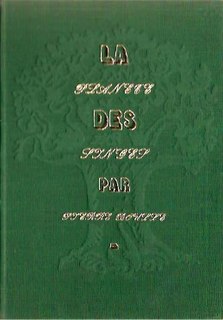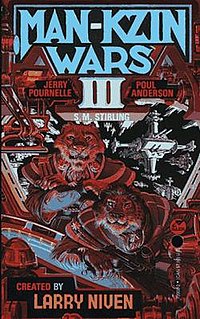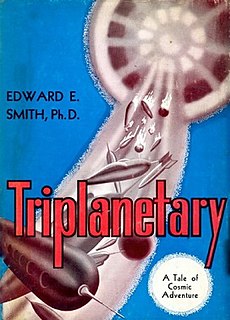Known Space is the fictional setting of about a dozen science fiction novels and several collections of short stories written by Larry Niven. It has also become a shared universe in the spin-off Man-Kzin Wars anthologies. The Internet Speculative Fiction Database (ISFDB) catalogs all works set in the fictional universe that includes Known Space under the series name Tales of Known Space, which was the title of a 1975 collection of Niven's short stories. The first-published work in the series, which was Niven's first published piece was "The Coldest Place", in the December 1964 issue of If magazine, edited by Frederik Pohl. This was the first-published work in the 1975 collection.
Mars, the fourth planet from the Sun, has appeared as a setting in works of fiction since at least the mid-1600s. It became the most popular celestial object in fiction in the late 1800s as the Moon was evidently lifeless. At the time, the predominant genre depicting Mars was utopian fiction. Contemporaneously, the mistaken belief that there are canals on Mars emerged and made its way into fiction. The War of the Worlds, H. G. Wells' story of an alien invasion of Earth by sinister Martians, was published in 1897 and went on to have a large influence on the science fiction genre. Life on Mars appeared frequently in fiction throughout the first half of the 1900s. Apart from enlightened as in the utopian works from the turn of the century or evil as in the works inspired by Wells, intelligent and human-like Martians also began to be depicted as decadent, a portrayal that was popularized by Edgar Rice Burroughs in the Barsoom series. Besides these, more exotic lifeforms appeared in stories like Stanley G. Weinbaum's "A Martian Odyssey". The theme of colonizing Mars replaced stories about native inhabitants of the planet in the second half of the 1900s following emerging evidence of the planet being inhospitable to life, eventually confirmed by data from Mars exploration probes. Terraforming Mars to enable human habitation has been another major theme, especially since the 1990s. Stories of the first human mission to Mars appeared throughout the 1990s in response to the Space Exploration Initiative. The moons of Mars—Phobos and Deimos—have made only sporadic appearances in fiction.

Between Planets is a juvenile science fiction novel by American writer Robert A. Heinlein, originally serialized in Blue Book magazine in 1951 as "Planets in Combat". It was published in hardcover that year by Scribner's as part of the Heinlein juveniles.

Stephen Baxter is an English hard science fiction author. He has degrees in mathematics and engineering.

Anne Inez McCaffrey was an American-Irish writer known for the Dragonriders of Pern science fiction series. She was the first woman to win a Hugo Award for fiction and the first to win a Nebula Award. Her 1978 novel The White Dragon became one of the first science-fiction books to appear on the New York Times Best Seller list.

La Planète des singes, known in English as Planet of the Apes in the US and Monkey Planet in the UK, is a 1963 science fiction novel by French author Pierre Boulle. It was adapted into the 1968 film Planet of the Apes, launching the Planet of the Apes media franchise.

The Songs of Distant Earth is a 1986 science fiction novel by British writer Arthur C. Clarke, based upon his 1958 short story of the same title. He stated that it was his favourite of all his novels. Clarke also wrote a short step outline with the same title, published in Omni magazine and anthologized in The Sentinel in 1983.
Eleanor Atwood Arnason is an American author of science fiction novels and short stories.

S is for Space (1966) is a collection of science fiction short stories written by Ray Bradbury. It was compiled for the Young Adult sections of libraries.

The Sands of Mars is a science fiction novel by English writer Arthur C. Clarke. While he was already popular as a short story writer and as a magazine contributor, The Sands of Mars was also a prelude to Clarke's becoming one of the world's foremost writers of science fiction novels. The story was published in 1951, before humans had achieved space flight. It is set principally on the planet Mars, which has been settled by humans and is used essentially as a research establishment. The story setting is that Mars has been surveyed but not fully explored on the ground. The Sands of Mars was Clarke's first published novel.

Inconstant Moon is a science fiction short story collection by American author Larry Niven that was published in 1973. "Inconstant Moon" is also a 1971 short story that is included in the collection. The title refers to "O, swear not by the moon, th' inconstant moon", a quote from the balcony scene in William Shakespeare's Romeo and Juliet. The collection was assembled from the US collections The Shape of Space and All the Myriad Ways.

The Man-Kzin Wars is a series of military science fiction anthologies and is the name of the first. The short stories detail the eponymous conflicts between mankind and the Kzinti, set in Larry Niven's Known Space universe. However, Niven himself has written only a small number of the stories; most were written by other science fiction writers, as Niven opened this part of the Known Space to collaboration in the form of a shared universe. The cover art for the books in the series is created by Stephen Hickman.
Saturn has made appearances in fiction since the 1752 novel Micromégas by Voltaire. In many of these works, the planet is inhabited by aliens that are usually portrayed as being more advanced than humans. The planet is occasionally visited by humans and its rings are sometimes mined for resources. The moons of Saturn have been depicted in a large number of stories, especially Titan with its Earth-like environment suggesting the possibility of colonization by humans and alien lifeforms living there.
The planetary systems of stars other than the Sun and the Solar System are a staple element in many works of the science fiction genre.

The Andromeda Nebula is a 1967 Soviet science fiction film starring Sergei Stolyarov and directed by Yevgeni Sherstobitov at the Dovzhenko Film Studios. The film was originally intended to be the first episode of a series of films, alternatively titled as The Andromeda Nebula: Episode I. Prisoners of the Iron Star, but the remaining parts were never made due to Stolyarov's death.

The Viagens Interplanetarias series is a sequence of science fiction stories by L. Sprague de Camp, begun in the late 1940s and written under the influence of contemporary space opera and sword and planet stories, particularly Edgar Rice Burroughs's Martian novels. Set in the future in the 21st and 22nd centuries, the series is named for the quasi-public Terran agency portrayed as monopolizing interstellar travel, the Brazilian-dominated Viagens Interplanetarias. It is also known as the Krishna series, as the majority of the stories belong to a sequence set on a fictional planet of that name. While de Camp started out as a science fiction writer and his early reputation was based on his short stories in the genre, the Viagens tales represent his only extended science fiction series.

Triplanetary is a science fiction novel and space opera by American writer E. E. Smith. It was first serialized in the magazine Amazing Stories in 1934. After the original four novels of the Lensman series were published, Smith expanded and reworked Triplanetary into the first of two prequels for the series. The fix-up novel Triplanetary was published in book form in 1948 by Fantasy Press. The second prequel, First Lensman, was a new original novel published in 1950 by Fantasy Press.

The Haunted Stars is a science fiction novel by American writer Edmond Hamilton. It tells the story of an expedition from Earth to a planet of the star Altair — a planet called Ryn, inhabited by humans like those on Earth. Against the wishes of Ryn's inhabitants, the team from Earth seek information about weapons technology used in an ancient space war. Their unsuccessful search ends in dramatic contact with another species, the ancient enemy of Ryn.

The Year's Best Science Fiction: Thirty-Fourth Annual Collection is an anthology of science fiction short stories edited by Gardner Dozois, the thirty-fourth volume in an ongoing series. It was first published in hardcover, trade paperback and ebook by St. Martin's Griffin in July 2017.

The Vanished Birds is a 2020 space opera novel, the debut work by Simon Jimenez. In a plot that spans millennia, the story focuses on the interconnected lives of several characters, including a boy whose special ability may hold the key to unlocking the secrets of the universe. The novel received critical acclaim. It was nominated for the 2021 Locus Award for Best First Novel and the 2021 Arthur C. Clarke Award.















